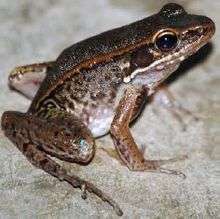Hylarana leptoglossa
| Long-tongued frog | |
|---|---|
 | |
| Hylarana leptoglossa, Samdrup Jongkhar District, Bhutan | |
| Scientific classification | |
| Kingdom: | Animalia |
| Phylum: | Chordata |
| Class: | Amphibia |
| Order: | Anura |
| Family: | Ranidae |
| Genus: | Hylarana |
| Species: | H. leptoglossa |
| Binomial name | |
| Hylarana leptoglossa (Cope, 1868) | |
| Synonyms | |
| |
Hylarana leptoglossa, commonly known as the long-tongued frog, is a species of true frog in the genus Hylarana. It is native to Bangladesh, northeastern India, Myanmar, and western Thailand. It is also known under the common names Cope's frog, Cope's Assam frog, palebrown small frog, and Assam forest frog.[2] It has recently been reported also from Bhutan.[3]
Hylarana leptoglossa live near streams in evergreen forests. They are generally found at moderate elevations, below 500 m (1,600 ft) in India and between 600–700 m (2,000–2,300 ft) in Thailand. Deforestation, fires, and agricultural encroachment can pose threats to this species.[1]
References
- 1 2 van Dijk, P.P.; Wogan, G.; Chan-ard, T.; Ohler, A.; Sengupta, S. & Asmat, G.S.M. (2009). "Hylarana leptoglossa". IUCN Red List of Threatened Species. Version 2013.1. International Union for Conservation of Nature. Retrieved 24 November 2013.
- ↑ Frost, Darrel R. (2013). "Hylarana leptoglossa (Cope, 1868)". Amphibian Species of the World 5.6, an Online Reference. American Museum of Natural History. Retrieved 24 November 2013.
- ↑ Wangyal, J. T. (2013). "New records of reptiles and amphibians from Bhutan". Journal of Threatened Taxa. 5 (13): 4774–4783. doi:10.11609/JoTT.o3539.4774-83.
This article is issued from
Wikipedia.
The text is licensed under Creative Commons - Attribution - Sharealike.
Additional terms may apply for the media files.
